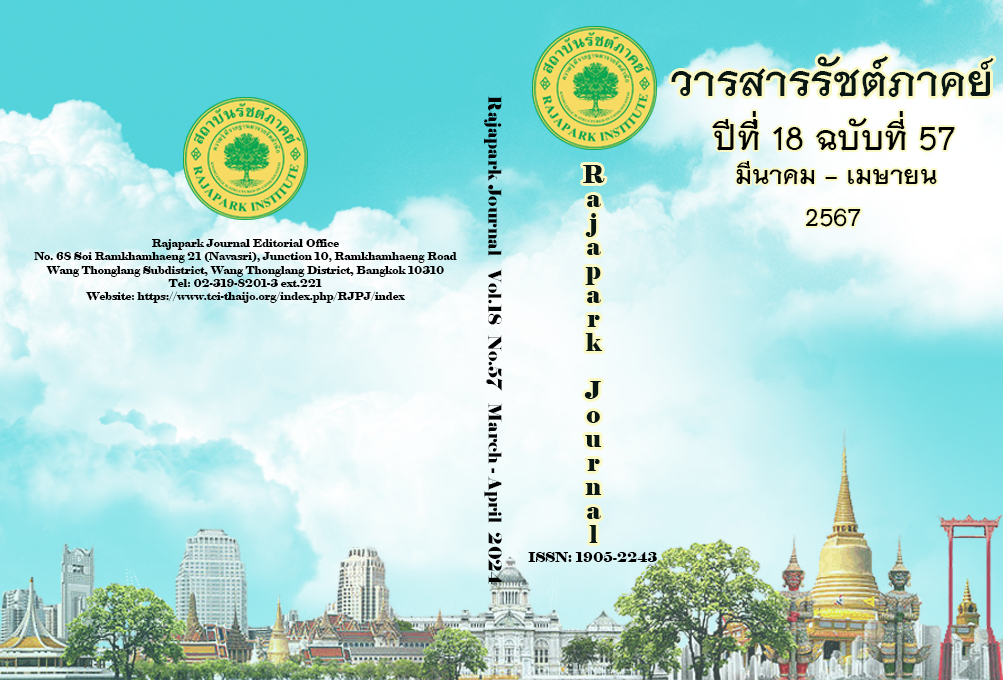Causal Factors that Influence Customer Loyalty for Hotel Industry: The Mediating Role of Relationship Marketing
Main Article Content
Abstract
The purpose of this research was to study the causal factors of service quality, information technology, and the aspect of creating joint value. It has a direct impact on relationship marketing as a transmission variable that affects the loyalty of resort business customers in Thailand. To study the influence of relationship marketing as a transmission variable affecting customer loyalty in resort businesses in Thailand. and to create a model of causal factors and the role of relationship marketing as a transmission variable affecting customer loyalty in resort businesses in Thailand. There were 440 people in the sample group who were Thai tourists and those traveling to resorts in Thailand. The research instruments were questionnaires, analysis, mean, and standard deviation, and the hypothesis was tested by analyzing the structural equation model using the Partial Least Square method. The findings revealed that the service quality factor, information technology factor, creating shared value factor, and overall levels are at a high level. For studying relationship marketing and customer loyalty, the research elucidated the importance of understanding the influence and causal relationship pattern of relationship marketing's role as a transmission factor affecting customer loyalty for resort businesses in Thailand.
Article Details

This work is licensed under a Creative Commons Attribution-NonCommercial-NoDerivatives 4.0 International License.
Views and opinions appearing in the Journal it is the responsibility of the author of the article, and does not constitute the view and responsibility of the editorial team.
References
Ali, O.M. (2020). The Roles of Relationships and Service Quality as Drivers of Customer Loyalty: An Empirical Study. Open Journal of Social Sciences, 8, 14-32. DOI: 10.4236/jss.2020.84002
Balakrishna Kanagal, N. (2016). An Extended Model of Behavioural Process in Consumer Decision Making. International Journal of Marketing Studies, 8(4), 87.
Basalamah, M. R., Moeljadi, M., Sunaryo, S., & Sudjatno, S. (2018). The Effect of Service Quality and Relationship Marketing Towards Customer Loyalty for Sharia Banking (Sharia Banking Study in Makassar Indonesia). International Review of Management and Marketing, 8(1), 107–114. https://econjournals.com/index.php/irmm/article/view/5843
Coltman, T., Tallon, P., Sharma, R., & Queiroz, M. (2015). Strategic IT alignment: Twenty-five years on. Journal of Information Technology, 30(2), 91-100. https://link.springer.com/article/10.1057/jit.2014.35
Daengroj, P. (2014). Tourism Industry into the 21st Century. Duangkamon.
Didarul Alam, M.M., & Mohd Noor, N.A. (2020). The Relationship Between Service Quality, Corporate Image, and Customer Loyalty of Generation Y: An Application of S-O-R Paradigm in the Context of Superstores in Bangladesh. SAGE Open, 10(2), 1-19. DOI:10.1177/2158244020924405
Dwilianingsih, N.A., & Indradewa, R. (2022). The Influence of Relationship Marketing and Service Quality with Customer Satisfaction Mediation Variables on Customer Loyalty. Quantitative Economics and Management Studies (QEMS), 3(4), 548–554.
Gumjudpai, S. (2019). Statistics for research on curriculum and teaching (Revised ed.). Faculty of Education, Sakon Nakhon Rajabhat University.
Gronroos, C. (2004). The Relationship Marketing Process: Communication, Interaction Dialogue and Value. Journal of Business and Industrial Marketing, 19(2), 99-113.
Gronroos, C. (2008). Service Logic Revisited: Who Create Values? And Who Co-Creates?. European Business Review, 20(4), 298-314.
Hamzaoui, A. A., & Tsegay, M. N. (2020). Creating Shared Value through the Mediating Role of CSR. Jonkoping International Business School, Jonkoping University. https://www.diva-portal.org/smash/record.jsf?pid=diva2%3A1434415&dswid=-367
Hasfar, M., Militina, T., & Achmad, G. N. (2020). Effect of Customer Value and Customer Experience on Customer Satisfaction and Loyalty PT Meratus Samarinda. International Journal of Economics, Business and Accounting Research (IJEBAR), 4(1), 84-94. https://jurnal.stie-aas.ac.id/index.php/IJEBAR/article/view/909
Jain, E., & Yadav, A. (2017). Marketing and Technology: Role of Technology in Modern Marketing. IOSR Journal of Business and Management (IOSR-JBM), 19(5), 49-53.
Kasikorn Research Center. (2022, October 19). Hotel and Lodging Business, 2023: Recovering Gradually, but at a Meager Pace (Current Issue No.3351). https://www.kasikornresearch.com/EN/analysis/k-econ/business/Pages/Hotel-z3351.aspx
Kim, K. (2018) A Case Study to Explore Applicability of Creating Shared Value (CSV) into Design Practice. In Storni, C., Leahy, K., McMahon, M., Lloyd, P. and Bohemia, E. (eds.), Design as a catalyst for change - DRS International Conference 2018, 25-28 June, Limerick, Ireland. https://doi.org/10.21606/drs.2018.223
Kotler, P., & Keller, K. (2009). Marketing Management (13th ed.). Pearson.
Kotler, P., & Armstrong, G. (2012). Principles of Marketing (14th ed). Pearson.
Li, F., Larimo, J., & Leonidou, L.C. (2021). Social Media Marketing Strategy: Definition, Conceptualization, Taxonomy, Validation, and Future Agenda. Journal of the Academy of Marketing Science, 49, 51–70.
Mandina, S.P. (2014). Contribution of CRM Strategies in Enhancing Customer Loyalty. Journal of Marketing Development and Competitiveness, 8(2), 69-87. http://www.na-businesspress.com/JMDC/MandinaSP_Web8_2_.pdf
Parasuraman, A., Zeithaml, V. A., & Berry, L. L. (1988). SERVQUAL: A Multi-item Scale for Measuring Consumer Perception of Service Quality. Journal of Retailing, 64(1), 12-40.
Parasuraman, A., Zeithaml, V. A., & Berry, L. L. (2013). A Conceptual Model of Service Quality and Its Implications for Future Research (SERVQUAL). Journal of Marketing, 49, 41-50. DOI:10.2307/1251430
Porter, M.E., & Kramer, M.R. (2011). Creating Shared Value. Harvard Business Review, 89, 62-77.
Ratnasari, D., & Ary Gumanti, T. (2019). Relationship Marketing, Service Quality, Satisfaction and Customers Loyalty of Bank Sharia Mandiri Banyuwangi. International Journal of Scientific & Technology Research, 8(6), 1-4.
Sinjaru, T. (2020). Research and statistical data analysis with SPSS and AMOS (18th ed). Business R&D General Partnership.
Tan, L. (2019). The Roles of Information Technology in Customer Relationship Performance, Employee User Satisfaction, Service Quality and Customer Satisfaction. Creative Components. https://dr.lib.iastate.edu/handle/20.500.12876/16802
Virakul, B. (2015). Global Challenges, Sustainable Development and Their Implication for Organizational Performance. European Business Review, 27(4), 430-446. DOI: 10.1108/EBR-02-2014-0018
Windiari, I., & Djumarno, D. (2021). The Effect of Service Quality, Customer Relationship Marketing, And Brand Image on Customer Loyalty and Customer Satisfaction as An Intervening Variable, DIJEFA, 1(6), 1048-1059. https://dinastipub.org/DIJEFA/article/view/742
Zakaria, A., Ahmad, S.S. Omar, M.W., & Alhady, S.M.A.S.A. (2018). The Effect of Relationship Marketing, Customer Satisfaction and Service Quality Towards Customer Loyalty: A Case Study in XYZ Sdn Bhd. International Journal of Accounting, Finance and Business, 3(11), 98-104.


